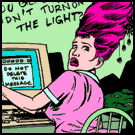|
FEBRUARY 2000 | VOL. 4, NO. 2 THAT'S LIFE RELATED ARTICLES RECENT ESSAY ANNIE L. CLARK FERREIRA, a linguist who works in Tewksbury, MA, is a contributing writer to Renaissance Online Magazine. PETER S. CONRAD is a cartoonist and illustrator in Northern California.
FULL ISSUE CONTENTS | TO BELIEVE OR NOT TO BELIEVE
Let's examine the "Kidney Snatcher" tale. A hapless traveler goes into the hotel/airport bar for a lonesome drink. A gorgeous (usually) woman offers to buy him that drink. He wakes up the next day in a tub of ice with a note saying "call 911 immediately if you want to live" taped to his body. He calls them, and because they are so familiar with this happening they know immediately that his kidneys have been removed, to be sold on the black market. Except you've never seen an article about it, never heard about it on the news. If this were true, and 911 operators were well-versed in kidney-snatching, don't you think you would have heard about it in some format other than e-mail? Many e-mails of the urban legend variety contain quotes from very real sounding people and organizations, even police and doctors. Many cite television news shows such as 20/20 or Extra!. But if you do a little research you find out that these people don't exist and 20/20 never did a piece on the alleged crime or legend. Another way to spot an urban legend is to look at the format of the mail. If the subject contains multiple exclamation points, and the body of the e-mail contains many words in all capital letters as well as myriad spelling and grammatical errors, this is a good indication that it is an urban legend or some other form of spam. One recent legend describes a spider that hides under toilet seats and gives a lethal bite to the rear. The spider comes from South America, and bites people on planes and in airport restaurants. Dr. Beverly Johnson of the American Medical Society called it Arachneus Gluteus. Literally, butt spider. Except there's no American Medical Society, there's no Dr. Beverly Johnson and there's no butt spider. If you do a little research, you can use the Internet itself to verify that this tale is false. Another form of urban legend preys upon another base human instinct: greed. These e-mails claim you can get a free car, free clothes from the Gap, or anywhere from $200 to $1 million just for forwarding this e-mail to as many people as you can. Except, if you check with your local computer expert or contact the Gap or Microsoft, you will find out that e-mail tracking to this extent does not exist, Gap is not going to give away free clothes, and Bill Gates is certainly not going to give you a million dollars just for forwarding an e-mail and annoying every one you know. Forward to your heart's content, spam everyone to tears, you will not get a free sweater. Some legends pull at your heartstrings, telling you about the poor little boy who's dying of cancer and his dying wish is to clutter your mailboxes, and oh yeah, the American Lung Society will donate a penny for each e-mail forwarded. Do a little research, contact the ALS, and you'll find out that this is not true and that no such boy exists. Many e-mails of this type play on guilt, asking you to pray for the child and send it on to everyone else so they can pray too. Another version of this is the Missing Child e-mail, telling you about the kidnapped baby. Again, five minutes of research gives you the information that such child never was kidnapped, if such a child even exists. If you really want to believe that an e-mail you receive has the power to bring you good luck, and destroy you if you don't forward it to ten people immediately, well, I have two things to say. First of all, did you get the one that says "This must leave your mailbox in 24 hours, or else!"? Well, even if you send out copies, most e-mail programs keep a copy of sent mail. So it hasn't "left your mailbox" after all. Furthermore, if you honestly believe this e-mail, I suggest you turn your computer off, pack it back up, return it to the store, go home, have the power and telephone shut off, build a circle of stones and sacrifice a live chicken. Welcome back to the Dark Ages. So, the next time you receive an e-mail from a dear friend which warns you about the gang member who slashes ankles while hiding under your car (not possible unless you have an SUV or a truck); telling you not to eat Kentucky Fried Chicken because it's made from synthetic bio-engineered "chickens"; warning you about the danger of using pay phones because you'll get infected with AIDS; or urging you to forward this e-mail on to save a child's life or get a free car; please, I beg you, go to the source of all evil, the Internet. I recommend www.snopes.com or the Urban Legends reference page of www.about.com. Both of these sites are very well organized, and you can search quickly for the legend you just received. The Snopes site has a chat forum, and people there will be only too happy to set you straight about any legend and will often give you numerous links and articles to back up their claims. Do this, verify that this "FW: fwd: Urgent Warning!!! (fwd) (fwd)" is in fact an urban legend, modern tall-tale, or flat out lie, and then please delete the e-mail and send it on no more. Or better yet, begin a collection as I have, so that each time a dire warning comes through, you can quickly check that it's a lie, and respond to the sender, telling them it's not true and asking them to send a retraction to all those to whom they sent the original mail. Urban legends have their place in our society, the same place that contains campfires, marshmallows, mosquitoes, and maybe even an owl. Fright tales about the roommate who slept through the murder in the next bed, only to awake the next morning with "Aren't you glad you didn't turn the light on?" scrawled in blood on the wall are fine for that place and time. But in this day and age where information is so readily available, these tales do not belong in e-mail. So, please, get back to work, or else this article will re-format your hard drive, give you the pox and donate a penny to the International Foundation of Spam. * * * * | |||||
ILLUSTRATION by Peter S. Conrad for Renaissance Online Magazine | ||||||


